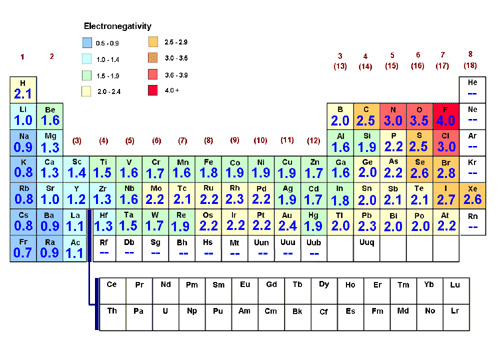
What is the difference in electronegativity between magnesium and chlorine when they form to react to form magnesium chloride?
Answer
511.8k+ views
Hint: Before answering this question, we should first know what is electronegativity. The ability of an atom to attract the electrons that are being shared to itself is known as electronegativity. It depends on the atomic number as well as the distance at which its outermost electron lies from the nucleus.
Complete answer:
Magnesium belongs to Group-2 i.e Alkaline earth metals whereas chlorine is a non-metal that belongs to Group-7 i.e Halogens. The two elements do not share electrons, So there is no covalent bonding between them.
The magnesium atom gives away two electrons and forms a stable 2+ ion of magnesium whereas the chlorine atom accepts the electron and forms a stable 1- ion of chlorine which results in the formation of an ionic bond.

The electronegativity of two elements are as follows:
Magnesium- 1.31
Chlorine- 3.16
We have to find out the difference in their electronegativities, we can subtract the smaller value of electronegativity from the bigger value of electronegativity.
\[\Delta En=E{{n}_{Cl}}-E{{n}_{Mg}}\]
$\Delta En=3.16-1.31$
$\vartriangle En=1.85$
Here ionic bonding happens because the electronegativity difference between the two elements is high and due to the difference in the electronegativity the ionic bond is polar.
The difference in the electronegativity values also tells that the bond between the cation and anion has an ionic character.
Therefore, Magnesium and chlorine will form an ionic bond in magnesium chloride.
Note:
The difference between Electronegativity and Electropositivity –
The ability of an atom to attract a shared pair of bonded electrons is electronegativity. Non-metals have high electronegativities compared to Metals.
The ability of an atom to donate electrons to form positively charged elements is electropositivity. Metallic elements have electropositivity.
Complete answer:
Magnesium belongs to Group-2 i.e Alkaline earth metals whereas chlorine is a non-metal that belongs to Group-7 i.e Halogens. The two elements do not share electrons, So there is no covalent bonding between them.
The magnesium atom gives away two electrons and forms a stable 2+ ion of magnesium whereas the chlorine atom accepts the electron and forms a stable 1- ion of chlorine which results in the formation of an ionic bond.

The electronegativity of two elements are as follows:
Magnesium- 1.31
Chlorine- 3.16
We have to find out the difference in their electronegativities, we can subtract the smaller value of electronegativity from the bigger value of electronegativity.
\[\Delta En=E{{n}_{Cl}}-E{{n}_{Mg}}\]
$\Delta En=3.16-1.31$
$\vartriangle En=1.85$
Here ionic bonding happens because the electronegativity difference between the two elements is high and due to the difference in the electronegativity the ionic bond is polar.
The difference in the electronegativity values also tells that the bond between the cation and anion has an ionic character.
Therefore, Magnesium and chlorine will form an ionic bond in magnesium chloride.
Note:
The difference between Electronegativity and Electropositivity –
The ability of an atom to attract a shared pair of bonded electrons is electronegativity. Non-metals have high electronegativities compared to Metals.
The ability of an atom to donate electrons to form positively charged elements is electropositivity. Metallic elements have electropositivity.
Recently Updated Pages
Why are manures considered better than fertilizers class 11 biology CBSE

Find the coordinates of the midpoint of the line segment class 11 maths CBSE

Distinguish between static friction limiting friction class 11 physics CBSE

The Chairman of the constituent Assembly was A Jawaharlal class 11 social science CBSE

The first National Commission on Labour NCL submitted class 11 social science CBSE

Number of all subshell of n + l 7 is A 4 B 5 C 6 D class 11 chemistry CBSE

Trending doubts
10 examples of friction in our daily life

One Metric ton is equal to kg A 10000 B 1000 C 100 class 11 physics CBSE

Difference Between Prokaryotic Cells and Eukaryotic Cells

1 Quintal is equal to a 110 kg b 10 kg c 100kg d 1000 class 11 physics CBSE

State the laws of reflection of light

Explain zero factorial class 11 maths CBSE




